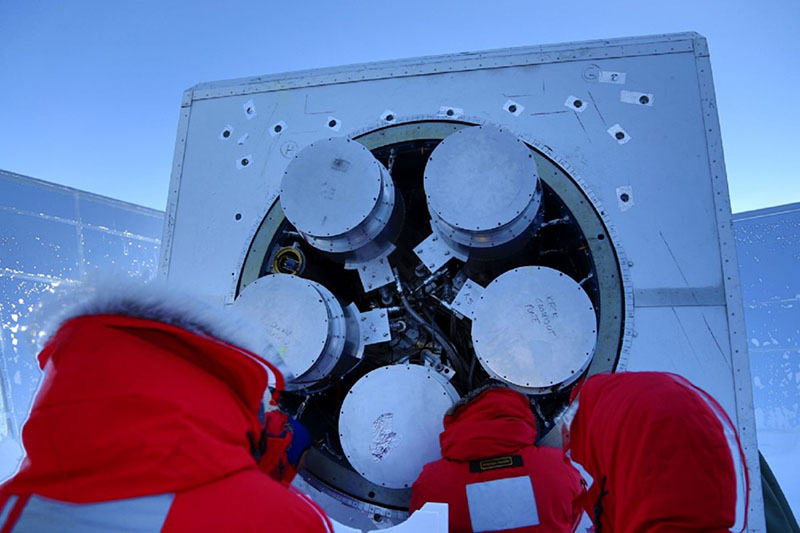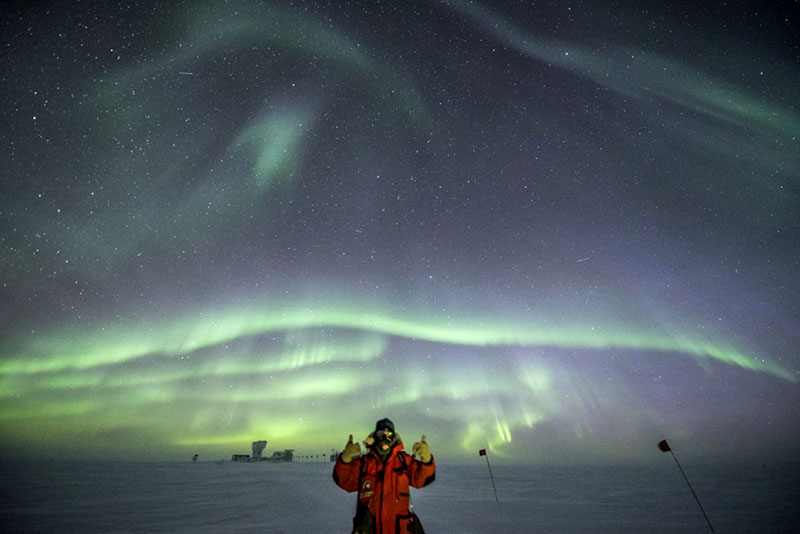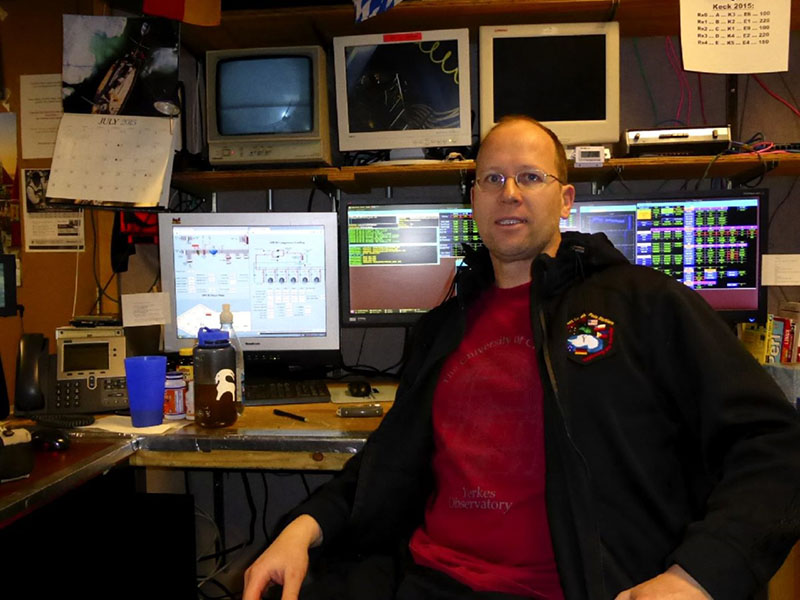A South Pole RecordRobert Schwarz has an Unparalleled History of Wintering at the South PolePosted October 11, 2018
The prospect of spending a winter at the desolate South Pole doesn't appeal to many. It's no small feat for the few dozen hearty souls each year who brave the constant below-freezing temperatures, half a year of darkness and lack of way to fly home for nearly nine months. But, for astrophysicist Robert Schwarz, of the University of Minnesota, who apparently holds a place unique in history, having spent so many winters at the end of the Earth, once was not nearly enough. "It's an absolutely amazing place," he said. Over the past 22 years, he's spent 14 Southern Hemisphere winters at the National Science Foundation's Amundsen-Scott South Pole Station. Though others have come close over the years, Schwarz, it seems, has spent more winters at the Pole than anyone else who has ever lived. The first people to spend the winter at the Pole were scientists and U.S. Navy personnel, all men, who lived there in the 1950's as part of the International Geophysical Year. Since then 1551 people, men and women, have wintered at 90 degrees South Latitude, some more than once, but none as many as Schwarz. NSF, which manages the U.S. Antarctic Program, has a Presidential mandate to run Amundsen-Scott and two other U.S. Antarctic research stations. Aside from being a part of history, during his numerous deployments, Schwarz also has documented history in the making, such as when he photographed, in 2016, the first midwinter medical evacuation from the Pole ever attempted. His dramatic images of that successful flight were featured by newspaper and television networks worldwide. Schwarz, who originally hails from Munich, Germany, started working at the Pole more or less by chance. One day while waiting to talk to his professor at the Max Planck Institute for Physics, Schwarz spotted an unusual job posting. "They were looking for someone to winter at South Pole, and I thought 'wow that sounds pretty amazing,'" Schwarz said. "I emailed to get more information and I got a one-liner back, that I should send a curriculum vitae and three references, and I did that and a week later they offered me the job." It goes without saying that taking time away from his graduate school to spend a winter overseeing science experiments at the South Pole was a bit of an unorthodox career move, but certainly not one he regrets. These days he is the winter overseer for the Keck Array, a cluster of microwave telescopes at the geographic South Pole. They're observing the echoes of the Big Bang embedded in the oldest light in the universe, the Cosmic Microwave Background. 
Photo Credit: Robert Schwarz
The five receivers of the Keck Array are shielded from blowing snow by its surrounding ground shield. The elevated station in the background is about half a mile away.
The 24 hours of mid-winter darkness, high elevation, cold, dry air and lack of light pollution make the Pole an ideal location for many types of astrophysics and particle-physics experiments, including Keck, but also the 10-meter South Pole Telescope. Even the miles-thick ice itself is the perfect medium for science, its crystal clarity making an ideal location for the IceCube Neutrino Observatory. "I'm basically here to keep the telescope running and make sure the data goes north," Schwarz said. "Mostly it's just maintenance and general stuff like keeping the computer system running, starting new schedules, and shoveling a lot of snow." In a way, he's like a doctor for the Keck instrument. He's there performing continual checkups to keep it running smoothly and fix it if something breaks down. "It's stuff I love to do, like the hands-on science," Schwarz said. "I always preferred a soldering iron or wrench, I don't too much like writing papers. [I'm] just trying to keep stuff running and if it doesn't run try to find out why, what is wrong, fix it and of course you never have all the spare parts you want and so you have to improvise, so that makes it kind of difficult but also very interesting and rewarding." A Sense of AdventureThe job first drew him in because of his sense of adventure and the uniqueness of the environment. "Antarctica itself, I mean, it's pretty amazing," Schwarz said. "Going to the geographic South Pole, who can do that? It was an absolutely awesome opportunity. The auroras and everything, and yeah, I guess I got a bit stuck." These days he spends more time at the South Pole station than anywhere else on Earth in a given year. He's seen a lot of changes during his time, with ups and downs of all kinds. However it was his first season that really hooked him. "The first one was definitely special, it was pretty awesome," Schwarz said. "It was a really good crew and I'm still in contact with most of the people." Though conceptually he knew what he was getting himself into, he added that there were a few times when the scope of spending a winter in one of the most isolated places in the world was palpable. "Your first winter when you see the last plane leave and you know there's not going to be another one for another eight and a half months, that's definitely a very memorable moment," Schwarz said. "Also your first sunset when you know that the sun is going to be gone now for six months, that's strange, you've never experienced something like that before." Working for nine months at a stretch at an isolated station with only about four dozen people for company might sound like a recipe for tedium, but, Schwarz said, "the contrary is actually true. Time is actually flying. Every year [time] always is flying and that goes by really quick, and it's never dragging along and certainly makes it easy to come back again." His work keeps him busy most of the time, but in the spare hours of the evening, there are always activities and social gatherings going on. Movie nights, board game nights, classes taught by other station residents and sports leagues in the gym are more than enough to keep folks occupied over the long winter months. "Normally the program is too full. It's like 'oh no, today there are already two things. Am I going to go to the movie night or will I go to board game night?" Schwarz said. Schwarz himself teaches a thirteen-week introduction to astronomy class. For the same reasons that make the South Pole skies perfect for scientific study, it's the ideal location for some amateur sky watching. The 24 hours of darkness, high elevation, cold, dry air and lack of light pollution mean that the skies above are some of the most spectacular in the world. Throw in some of the most dramatic multicolored aurora in the world and there's almost nothing in the world that compares to the lightshow overhead. 
Photo Credit: Robert Schwarz
During the brief summer, researchers work to install a receiver on to the Keck array.
"One of the Best Commutes in the World"One of the perks of the job is that it's a sight that he gets to enjoy almost every day. The Keck Array is housed in the Martin A. Pomerantz Observatory, a half-mile away from the station. Each day, after donning his protective winter clothing, Schwarz heads out from the main station across the polar plateau, in temperatures sometimes as low as 100 degrees below zero Fahrenheit. "When the weather stinks it can be a bit miserable but otherwise it's one of the best commutes in the world," Schwarz said. "You look up, especially when it's dark, and you see the stars in the sky and the auroras. And one of my favorites is when the auroras are actually lighting up the snow they're so bright. You actually see all the features in the snow on the ground and you look up and you see this awesome display." Much about the station has changed since he started working there. The facilities and the experiments have all had major upgrades in the 22 years since he first set foot at "90 South." When he first arrived at the station, Schwarz was overseeing the winter operations of the AMANDA neutrino detector, the forerunner to today's IceCube Neutrino Observatory. He first arrived in late 1996 and spent the austral winter of 1997 working at the detector. The next year he returned and spent the winter of 1998 reprising his role at the observatory. He returned briefly during the summer of 1999 then took some time to finish his degree. He returned again to AMANDA in 2003 into winter of 2004, then jumped from the neutrino experiment, to the adjacent microwave telescopes studying the ancient echoes of the big bang. Large telescopes with lenses that rotate to track with the movements of the Earth were a change from AMANDA's optical detectors buried under the ice. "With AMANDA it was all just computer and electronics in the building, you actually didn't see the modules after you deployed them," Schwarz said. "Having a telescope mount that actually moves around was a nice change, but brought a number of new challenges with it, like with the wear and everything. But it was not a big problem to switch." He spent the winters of 2005, 2006, and 2007 working on the former QUaD telescope, then when the Keck Array came online in 2010, he’s returned to it every year since. So Much Potential to LearnThe station itself has changed tremendously during his tenure. A domed station, built during the 1970's was phased out over the course of his many winters and dismantled. The current elevated station was built “from the ice up." "It was during the main construction phase of the new station," Schwarz said. "That was also somewhat interesting but also kind of challenging to see that construction of the new station and see how wing after wing got added. But basically living in a construction zone had its own challenges." Back during the days of the dome, winter crews were smaller, usually about 30 people, as opposed to between about 40 and 50 people now. At its peak, one winter there were 86 people on station while the new station was being completed. "The dome had quite its own flare. The days that I was there were the mid to late 90's, so it was before Facebook and all this stuff, so you were a little bit off the grid."
-Robert Schwarz
Construction on the new elevated station wrapped up in 2008 and once it did, numerous new amenities were available for the crew. "Having a nearly full-sized gym is awesome. The rooms are quite nice, especially the ones in A1 (wing) that are the bigger rooms we use in winter," Schwarz said. "What is really nice is now that we have a bigger greenhouse, we basically have freshies all winter long, at least basic freshies like salad and cucumber and tomatoes. That's definitely very nice, and it makes a huge difference." Still, he has a bit of a soft spot for the old days. "The dome had quite its own flare," he said. "The days that I was there were the mid to late 90's, so it was before Facebook and all this stuff, so you were a little bit off the grid." Even with the increased connectivity, the station is still quite isolated from the rest of the world. At no time is that more apparent than during a crisis, such as the midwinter medical evacuation, in 2016, the first ever attempted. He photographed the successful flight, and his images of it were used by the press worldwide." "Incidents like accidents and stuff like that, the station just pulls together because suddenly you have something that's like wow, that's something really serious and everybody just pulls their weight, and everybody helps out," Schwarz said. "Before, you have your biggest problems are which lights are on and off, or who's slamming what door, that's basically your main topics. Suddenly you realize there's something serious going on." Even when all is going well, the winter crews form tight bonds with each other. This sense of camaraderie and teamwork is one of the aspects of winter life that keep Schwarz coming back. "There's so much potential here to learn new stuff which is cool… Everybody who's down here in their profession is absolutely eager to share some of their knowledge and show you some stuff," Schwarz said. "People come out to the telescopes and want to find out more, and it’s pretty cool, it's like hands on science." |



For USAP Participants |
For The Public |
For Researchers and EducatorsContact UsU.S. National Science FoundationOffice of Polar Programs Geosciences Directorate 2415 Eisenhower Avenue, Suite W7100 Alexandria, VA 22314 Sign up for the NSF Office of Polar Programs newsletter and events. Feedback Form |



